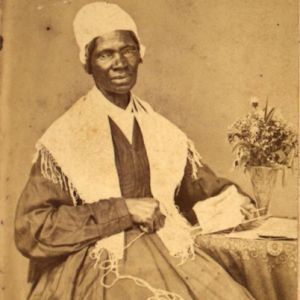|
In 1797, a young girl named Isabella was born into slavery in Ulster County, New York. Her parents were named James and Betsy, they were owned by Colonel Johannes Hardenbergh. As a young girl Isabella did not speak English, she only spoke what is called low Dutch and she could not read or write. Isabella would marry a man named Thomas who was also enslaved and the couple produced five children. Between 1815 and 1826 she was sold to four different slave owners on four different occasions. In 1826, Isabella had enough and decided to escape slavery and claim her freedom. She made her home in New York City until 1843 when she began traveling the country as a Preacher fighting injustices. One of the major changes Isabella made in her life was the changing of her name; she chose the name Sojourner Truth. Her name fit her mission as an abolitionist; she was determined to combat slavery. Throughout her travels Truth would live in Massachusetts and Ohio, she slowly built a name for herself from the Midwest to the Southeast. She was able to build alliances with fellow abolitionist and freedom fighters; she also found a way to support herself by selling self-portraits. Truth also made a living by selling her biography, The Narrative of Sojourner Truth, A Northern Slave, which was written by Olive Gilbert in 1850. Sammy Banks, the grandson of Truth joined her in her fight against slavery, he could read and write so he was very useful to her. In 1856, she traveled to Battle Creek, Michigan via invite to speak in front of a group of Quakers who were considered radical. She would eventually move to Battle Creek, Michigan ten years later, converting an old barn into her home. During the 1860’s, Truth found herself working for the Freedman’s Bureau at a time when ex-slaves were looking for refuge. Her mission with the bureau was to push for improved conditions for blacks at the Freedman’s Village. A huge number of ex-slaves were coming from Washington D.C. with no place to live or turn. Many were able to live at the Freedman’s Village but still managed to experience inhumane conditions. The children of the slaves were often kidnapped by the residents of Maryland, and when the parents complained they were punished. Truth became aware of the conditions the people were living in and lead a protest against the village. She was threatened immediately with detainment, but as a true hero she took the mission head on. Truth became instrumental in helping ex-slaves travel across the country to start a new life. She was relentless in her efforts to lobby the government for free land for the ex-slaves, and to cover the cost of their relocation. Truth is most notable for the speech widely but inaccurately known as “Ar’n’t I a Woman?” She gave an address at a women’s rights convention in 1851, but the speech she gave was not the “Aint I a Woman” version. The original version of the speech was published by Marius Robinson in the 1852 issue of The Anti-Slavery Bugle. The “Ar’n’t I A Woman?” version was published by Frances Gage; she added the “Ar’n’t I A Woman?” phrase and added a more southern dialect. The Gage version of the speech was published in 1863. The purpose of the address was to bring awareness to the plight of women and to fight for equality. On September 26th, 1883 Sojourner Truth died in her home at the age of 86. It is reported that 1,000 people attended her funeral to honor her. Truth devoted her life to literally freeing her people from enslavement, and helping to improve race relation throughout the country. Madame Sojourner Truth, we proudly stand on your shoulders. J.A. Ward. References:
https://www.thesojournertruthproject.com/compare-the-speeches/ https://www.biography.com/people/sojourner-truth-9511284 https://www.history.com/topics/black-history/sojourner-truth https://en.wikipedia.org/wiki/Sojourner_Truth
0 Comments
Leave a Reply. |
Details
Categories
All
Click Here to join our mailing list
|
Contact Us: |
Connect With Us |
Site powered by PIT Web Design


 RSS Feed
RSS Feed



